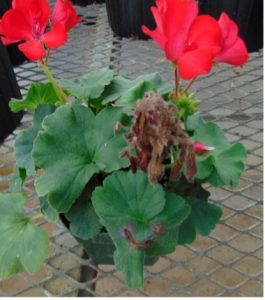Managing Botrytis on Bedding Plants
Author: Charles Krasnow
Charles.Krasnow@uconn.edu
Reviewers: Ana Legrand, UConn Extension
Publication: EXT144 | July, 2025
Introduction
Bedding plants comprise an important segment of the Connecticut greenhouse industry, worth close to $350 million annually. These crops, which include pansy, geranium, bedding impatiens, New Guinea impatiens, snapdragon, coleus, and others are popular with home gardeners and in beautiful landscapes, and are sold in retail and wholesale outlets throughout the region.
This fact sheet covers the identification of gray mold and its cause, and the impact and management of Botrytis cinerea in bedding plants.
Identification and Management
Bedding plant production has increased significantly in recent years. Improved growing techniques and hygenic growing conditions have reduced the impact of many diseases. Botrytis cinerea, causing gray mold, continues to be a consistent threat to the successful production of bedding plants. Most commercially produced bedding plants are susceptible to the pathogen during all stages of production.
Management Techniques for Botrytis
- Maintain healthy stock plants
- Monitor cuttings regularly during misting and propagation;
- Use bleach (10%) or ethanol (70%) to sterilize tools;
- Remove debris from the greenhouse;
- Keep trash containers covered;
- Limit overhead irrigation;
- Reduce leaf wetness;
- Used forced air under benches;
- Ventilate the greenhouse;
- Space plants for improved air circulation.
Botrytis is able to grow at a wide range of temperatures and can survive as a necrotroph on decaying plant parts. The pathogen produces large masses of gray spores that can be carried by air currents to neighboring plants in the greenhouse. The spores are produced on infected plants, or on leaves on the greenhouse bench or floor.
The pathogen is widespread in greenhouses and produces abundant conidia that spread easily in air currents. Often dead leaves on the greenhouse floor that are covered by gray ‘fuzz’ are actually Botrytis. Flowers provide an especially good source of nutrients for the pathogen.

Symptoms and Environmental Conditions
The initial symptoms of gray mold usually appear as a brown lesion on leaves or petals. Infections can start as small spots on the leaves and increase in size rapidly when conditions are favorable. The entire leaf and stem become covered with brown-gray sporulation. A cloud of gray spores can often be observed from sporulating plant tissue.
Mature plants are at high risk of infection. In some cases, Botrytis will infect the stems and crown causing the plant to wilt. Sporulation will appear on diseased stems when humidity is high. During transport and shipping of bedding plants, high humidity and temperature changes can cause condensation in shipping containers leading to ideal conditions for the pathogen.
Environmental conditions are a major factor in the success of Botrytis. High relative humidity (>93%) is necessary for infection to occur. These humidity levels are observed in most greenhouses. Frequent misting during propagation provides an ideal environment for Botrytis, and this is a time when the need for fungicide application is heightened.
Monitor seedlings that are under mist to ensure that the pathogen does not become established. When temperatures in the greenhouse drop in the evening and humidity remains high, condensation can form providing moisture required for infection. One way to control Botrytis is to keep the greenhouse and plants dry.
Improving air flow and using heated forced air under benches can prevent periods of localized high humidity in the plant canopy. Appropriate plant spacing and avoiding pooling water on flood floors is helpful in reducing high relative humidity around the plants.
Management with Fungicides
Fungicides are an important tool for managing gray mold. There are many fungicides currently labeled for Botrytis blight. Using fungicides preventively will help to reduce the chances of infection. Rotating among various groups examined by the Fungicide Resistance Action Committee (FRAC) is important to reduce the chances of fungal resistance. Fungal resistance can make the fungicide ineffective.
Fungicides effective against Botrytis (read labels)
| Product | Active Ingredient | FRAC Code | |
| Class A* | Decree | Fenhexamid | 17 |
| Mural | Azoxystrobin+Benzovindiflupyr | 11/7 | |
| Empress | Pyraclostrobin | 11 | |
| Astun | Isofetamid | 7 | |
| Postiva | Pydiflumetofen+Difenoconazole | 3/7 | |
| Pagent Intrinsic | Pyraclostrobin+Boscalid | 11/7 | |
| Draconil | Chlorothalonil | M5 | |
| Broadform | Fluopyram+Trifloxystrobin | 11/7 | |
| Class A- | Heritage | Azoxystrobin | 11 |
| Palladium | Cyprodinil+Fludioxonil | 9/12 | |
| Orkestra | Fluxapyroxad+Pyraclostrobin | 11/7 | |
| 3336 | Thiophanate-methyl | 1 | |
| Chipco 26019 | Iprodione | 2 |
*Use Class A fungicides when disease pressure is especially high.

Resources
Daughtrey, M, Wick, R, Peterson, J. 2000. Botrytis Blight of Flowering Potted Plants. Plant Health Progress doi:10.1094/PHP-2000-0605-01-HM.
Hausbeck, M. 2017. B is for Botrytis blight on ornamentals. https://www.canr.msu.edu/news/botrytis_blight_on_ornamentals
USDA NASS Report, 2022. https://www.nass.usda.gov/Publications/AgCensus/2022/Full_Report/Volume_1,_Chapter_1_State_Level/Connecticut/ctv1.pdf
The information in this document is for educational purposes only. The recommendations contained are based on the best available knowledge at the time of publication. Any reference to commercial products, trade or brand names is for information only, and no endorsement or approval is intended. UConn Extension does not guarantee or warrant the standard of any product referenced or imply approval of the product to the exclusion of others which also may be available. The University of Connecticut, UConn Extension, College of Agriculture, Health and Natural Resources is an equal opportunity program provider and employer.